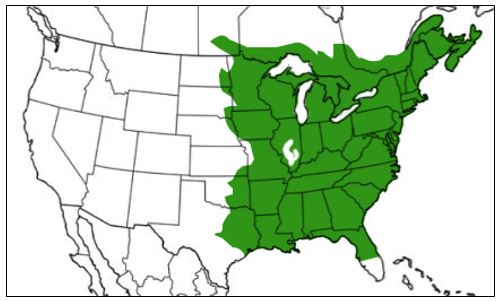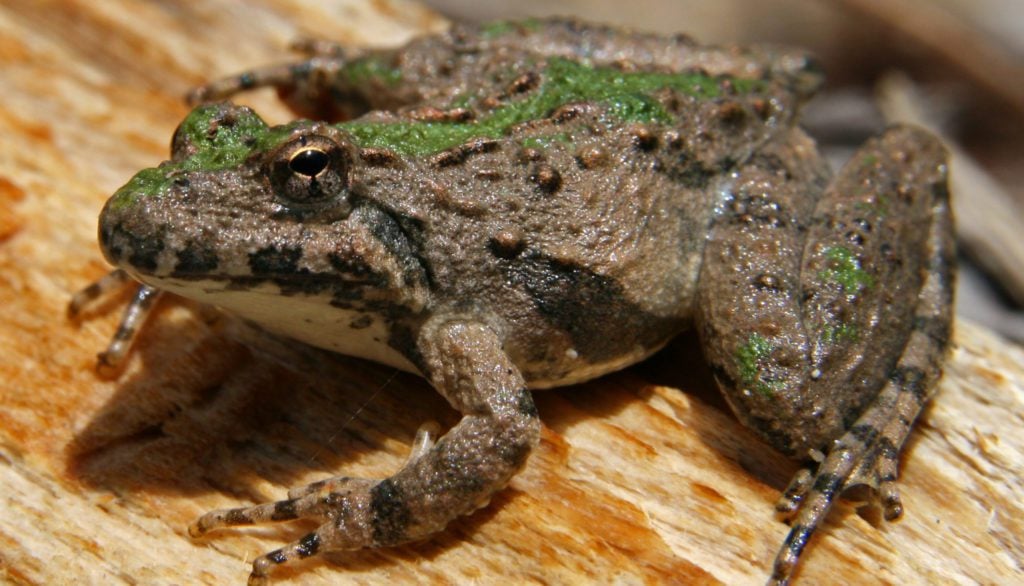5 Types of Frogs Found in South Dakota! (ID Guide)
“What kind of frogs can you find in South Dakota?”

I love finding, observing, and hearing frogs!
Even as a kid, I used to patrol the swamps by my house, catching them and then trying to sell them as pets to cars passing by. As you can imagine, no one was interested in buying my frogs, and I ended up letting them go at the end of each day. 🙂
Today, I’m providing a guide to teach you about the different kinds of frogs found in South Dakota.
One of the BEST ways to find frogs is to learn the noises they make. So, in addition to pictures, you will find audio samples for each species below!
5 Frog Species in South Dakota:
-
RELATED: 13 Common SNAKES That Live in South Dakota! (ID Guide)
-
RELATED: What Are The 6 Types of TURTLES Found in South Dakota?
-
RELATED: 4 Types of Toads Found in South Dakota! (ID Guide)
#1. American Bullfrog
- Lithobates catesbeianus

Identifying Characteristics:
- Adult body lengths range from 3.6 to 6 inches.
- Coloration is typically olive green, with some individuals having gray or brown mottling or spots.
- Fully webbed back feet.
The American Bullfrog is the largest frog in South Dakota!
Believe it or not, they can grow to weigh as much as 1.5 pounds (.7 kg).
American Bullfrog Range Map

Green = native range. Red = introduced range.
Bullfrogs can be found in permanent bodies of water, including swamps, ponds, and lakes. During the breeding season, the male frogs select egg sites in shallow waters, which they defend aggressively. A female will then select a male by entering his territory.
They are named for their deep call, which is thought to sound like a bull bellowing.

Bullfrogs are known to eat just about anything they can fit in their mouth and swallow! The list of prey includes other frogs, fish, turtles, small birds, bats, rodents, insects, crustaceans, and worms. I have personally witnessed one even trying to eat a baby duck!
#2. Northern Leopard Frog
- Lithobates pipiens

Identifying Characteristics:
- Adults range from 2 to 4.5 inches long.
- Smooth skin is green, brown, or yellow-green with large dark spots.
- Lighter-colored raised ridges extend down the length of the back.
You can spot Northern Leopard Frogs in South Dakota near slow-moving bodies of water with lots of vegetation. You might see them in or near ponds, lakes, streams, and marshes. I love how bright green most individuals appear!
Northern Leopard Frog Range Map

Due to their fairly large size, these frogs eat various foods, including worms, crickets, flies, and small frogs, snakes, and birds. In one study, a bat was even observed being eaten!
During the spring breeding season, the males will float in shallow pools emitting a low call thought to sound a bit like snoring. The Northern Leopard Frog may also make a high, loud, screaming call if captured or startled.

Northern Leopard Frog populations are declining in many areas, and the cause is not exactly known. It’s thought to be some combination of habitat loss, drought, introduced fish, environmental contaminants, and disease.
#3. Green Frog
- Lithobates clamitans

Identifying Characteristics:
- Adult body lengths range from 2 to 4 inches, and the females are typically larger than males.
- Coloration is normally green or brown with darker mottling or spots on the back.
- Ridges run down the sides of the back and they have webbed hind feet.
Green Frogs are found in eastern South Dakota.
Green Frog Range Map

Look for them in permanent bodies of water, including lakes, ponds, swamps, and streams. They spend most of their time near the shoreline but jump into deeper water when approached. They also breed and lay eggs near the shore, typically in areas with aquatic vegetation.
The Green Frog produces a single note call that is relatively easy to identify. Listen for a noise that sounds like a plucked banjo string, which is often repeated.

To hunt, they use a “sit and wait” approach, so they are fairly opportunistic. Green Frogs will try to eat almost anything they can fit inside their mouth. The list includes spiders, insects, fish, crayfish, snails, slugs, small snakes, and even other frogs!
#4. Plains Leopard Frog
- Lithobates blairi

Identifying Characteristics:
- Adults are 2 to 3.75 inches long.
- Tan or light brown coloration with dark brown or greenish spots.
- A distinct white line on the upper jaw and lighter ridges running down the sides of the back.
As the name suggests, this frog is found on the plains of southern South Dakota.
Plains Leopard Frog Range Map

The Plains Leopard Frog is almost always seen around permanent bodies of water, including streams, creeks, ponds, and marshy areas. They primarily eat insects, although these opportunists will eat almost any living thing they can fit in their mouth (including other frogs).
During the breeding season, the males produce a guttural, rapid “chuck-chuck-chuck” call.

The Plains Leopard Frog is relatively common but can be hard to see. First, they are nocturnal. Second, they are shy and dive into the water as soon as they are approached!
#5. Boreal Chorus Frog
- Pseudacris maculata
Identifying Characteristics:
- Adults range from 1 to 1.5 inches long.
- Coloration is brown, olive green, or tan with three dark stripes down the back that are sometimes broken into blotches.
- Prominent black stripe on each side from nostril, through the eye, and down the sides to the groin.
- Looks very similar to the Western Chorus Frog. Boreal Chorus Frogs are distinguished by having shorter legs.
While the Boreal Chorus Frog can be common in South Dakota, they are rarely seen. They’re small and secretive, inhabiting moist meadows and forests near wetlands.
Boreal Chorus Frog Range Map
Credit: U.S. Geological Survey, Department of the Interior/USGS
These frogs breed in shallow temporary ponds and pools such as flooded fields and roadside ditches. They require waters free of fish; otherwise, most of their eggs and tadpoles would be eaten!
Males produce a loud chorus of calls at breeding sites, which are easy to identify.

The sound has been compared to someone running a finger over the teeth of a comb (“reeeek“). You’re most likely to hear the calls in the late afternoon or evening.
#6. Blanchard’s Cricket Frog
- Acris blanchardi

Identifying Characteristics:
- Adults range from 0.6 to 1.5 inches long.
- Warty skin is typically tan, brown, olive green, or gray with darker banding on the legs.
- Dark triangular mark between the eyes on the head.
Blanchard’s Cricket Frogs can be found in or near permanent bodies of water in southeast South Dakota, including bogs, lakes, ponds, marshes, and slow-moving rivers and streams. They can also sometimes be spotted in temporary bodies of water such as flooded fields and drainage ditches as long as there is a permanent water source nearby.
Blanchard’s Cricket Frog Range Map

Interestingly, although they are in the “treefrog” family, they spend most of their time on the ground and in the water.
Unfortunately, Blanchard’s Cricket Frogs are declining in parts of their range and are considered threatened. They face habitat loss, chemical contamination, and competition for resources. Another pressure they face is their short life span, as the average individual only lives one year.
Males make unique, repetitive, metallic breeding calls.

The calls are thought to sound like two pebbles or marbles being clicked together. The females lay small clusters or even single eggs, and the tadpoles emerge in late summer.
Do you need additional help identifying frogs?
Try this field guide!
Which of these frogs have you seen in South Dakota?
Leave a comment below!



